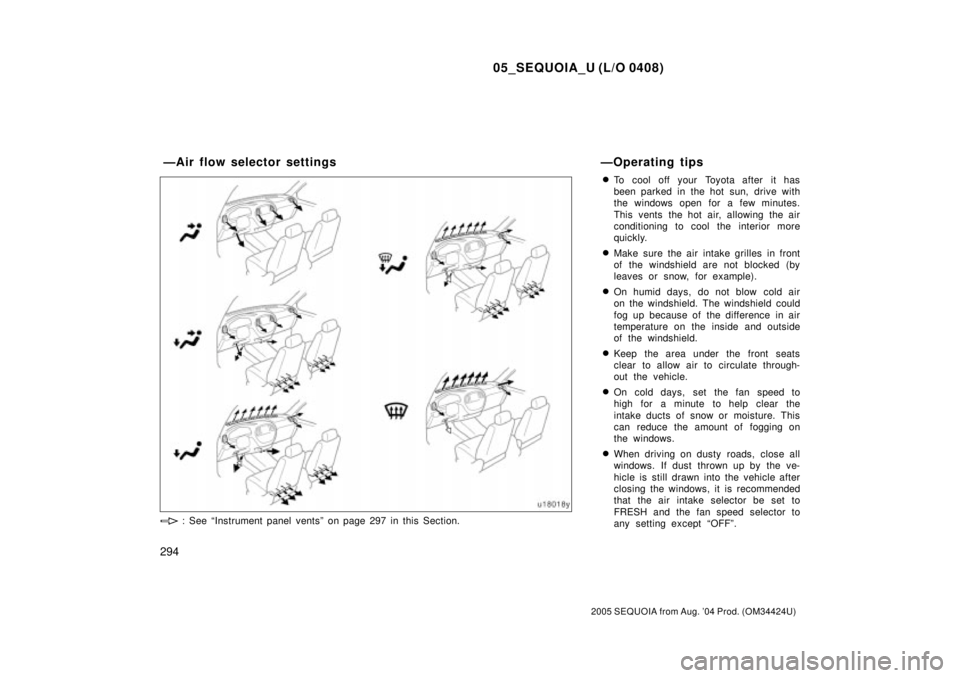Page 4153 of 4323

05_SEQUOIA_U (L/O 0408)
294
2005 SEQUOIA from Aug. '04 Prod. (OM34424U)
�To cool off your Toyota after it has
been parked in the hot sun, drive with
the windows open for a few minutes.
This vents the hot air, allowing the air
conditioning to cool the interior more
quickly.
�Make sure the air intake grilles in front
of the windshield are not blocked (by
leaves or snow, for example).
�On humid days, do not blow cold air
on the windshield. The windshield could
fog up because of the difference in air
temperature on the inside and outside
of the windshield.
�Keep the area under the front seats
clear to allow air to circulate through-
out the vehicle.
�On cold days, set the fan speed to
high for a minute to help clear the
intake ducts of snow or moisture. This
can reduce the amount of fogging on
the windows.
�When driving on dusty roads, close all
windows. If dust thrown up by the ve-
hicle is still drawn into the vehicle after
closing the windows, it is recommended
that the air intake selector be set to
FRESH and the fan speed selector to
any setting except ªOFFº.
ÐAir flow selector settings
: See ªInstrument panel ventsº on page 297 in this Section.
ÐOperating tips
Page 4180 of 4323
05_SEQUOIA_U (L/O 0408)
321
2005 SEQUOIA from Aug. '04 Prod. (OM34424U)
The auxiliary box type E is equipped
with a strap to hold the third seat cen-
ter head restraint.
Store the head restraint in the auxiliary
box when it is not is use. Storing proce-
dures are as follows:
1. Store the removed head restraint, with
its legs in the hole, in the auxiliary
box.2. Attach the straps.
Make sure the head restraint is securely
held in place.
Page 4185 of 4323
05_SEQUOIA_U (L/O 0408)
326
2005 SEQUOIA from Aug. '04 Prod. (OM34424U)
UPPER TRAY
To access the upper tray, pull up the
lock release lever and raise the console
box lid.
Removable console box (with
separate type second seat)
Page 4188 of 4323
05_SEQUOIA_U (L/O 0408)
329
2005 SEQUOIA from Aug. '04 Prod. (OM34424U)
Type A (instrument panel)
Type B (front side of rear console box)
Type C (rear side of rear console box)
Type D (rear side trim)
To secure your luggage, use the tie±
down hooks as shown above.
See ªÐStowage precautionsº on page 356
in Section 2 for precautions when loading
luggage.
CAUTION
To avoid personal injury, keep the tie±
down hooks folded in place on the
floor when not in use.
NOTICE
Do not use the seat anchors instead
of the tie±down hooks.
Tie±down hooks
Page 4193 of 4323

05_SEQUOIA_U (L/O 0408)
334
2005 SEQUOIA from Aug. '04 Prod. (OM34424U)
This vehicle belongs to the utility ve-
hicle class, which has higher ground
clearance and narrower tread in relation
to the height of its center of gravity to
make it capable of performing in a wide
variety of off±road applications. Specific
design characteristics give it a higher
center of gravity than ordinary passen-
ger cars. This vehicle design feature
causes this type of vehicle to be more
likely to rollover. And, utility vehicles
have a significantly higher rollover rate
than other types of vehicles. An advan-
tage of the higher ground clearance is
a better view of the road allowing you
to anticipate problems. It is not de-
signed for cornering at the same
speeds as ordinary passenger cars any
more than low±slung sports cars de-
signed to perform satisfactorily under
off±road conditions. Therefore, sharp
turns at excessive speeds may cause
rollover.CAUTION
Always observe the following precau-
tions to minimize the risk of serious
personal injury or damage to your ve-
hicle:
�In a rollover crash, an unbelted per-
son is significantly more likely to
die than a person wearing a seat
belt. Therefore, the driver and all
passengers should fasten their seat
belts whenever the vehicle is mov-
ing.
�Avoid sharp turns or abrupt maneu-
vers, if at all possible. Failure to
operate this vehicle correctly may
result in loss of control or vehicle
rollover causing death or serious
injury.
�Loading cargo on the roof luggage
carrier will make the center of the
vehicle gravity higher. Avoid high
speeds, sudden starts, sharp turns,
sudden braking or abrupt maneu-
vers, otherwise it may result in loss
of control or vehicle rollover due to
failure to operate this vehicle cor-
rectly.
Off±road vehicle precautions
Page 4211 of 4323

05_SEQUOIA_U (L/O 0408)
352
2005 SEQUOIA from Aug. '04 Prod. (OM34424U)
Ti r e relat ed ter mMeaning
Accessory weight
the combined weight (in excess of those standard items which may be
replaced) of automatic transmission, power steering, power brakes, power
windows, power seats, radio, and heater, to the extent that these items
are available as factory±installed equipment (whether installed or not)
Cold tire inflation pressure
tire inflation pressure when the vehicle has been parked for at least 3
hours or more, or it has not been driven more than 1.5 km or 1 mile
under that condition
Curb weight
the weight of a motor vehicle with standard equipment including the
maximum capacity of fuel, oil, and coolant, and, if so equipped, air
conditioning and additional weight optional engine
Intended outboard sidewall
(A) the sidewall that contains a whitewall, bears white lettering or bears
manufacturer, brand, and/or model name molding that is higher or
deeper than the same molding on the other sidewall of the tire, or
(B) the outward facing sidewall of an asymmetrical tire that has a particular
side that must always face outward when mounted on a vehicle
Maximum inflation pressurethe maximum cold inflation pressure to which a tire may be inflated and it
is shown on the sidewall of the tire
Maximum loaded vehicle weight
the sum ofÐ
(a) curb weight;
(b) accessory weight;
(c) vehicle capacity weight; and
(d) production options weight
ÐGlossary of tire terminology
Page 4212 of 4323

05_SEQUOIA_U (L/O 0408)
353
2005 SEQUOIA from Aug. '04 Prod. (OM34424U)
Ti r e relat ed ter mMeaning
Normal occupant weight68 kg (150 lb.) times the number of occupants specified in the second
column of Table 1 that follows
Occupant distributiondistribution of occupants in a vehicle as specified in the third column of Table
1 that follows
Production options weight
the combined weight of those installed regular production options weighing
over 2.3 kg (5 lb.) in excess of those standard items which they replace,
not previously considered in curb weight or accessory weight, including
heavy duty brakes, ride levelers, roof rack, heavy duty battery, and special
trim
Recommended inflation pressurecold tire inflation pressure recommended by a manufacturer
Rima metal support for a tire or a tire and tube assembly upon which the tire beads
are seated
Rim diameter (Wheel diameter)nominal diameter of the bead seat
Rim size designationrim diameter and width
Rim type designationthe industry of manufacturer 's designation for a rim by style or code
Rim widthnominal distance between rim flanges
Vehicle capacity weight
(Total load capacity)the rated cargo and luggage load plus 68 kg (150 lb.) times the vehicle's desig-
nated seating capacity
Vehicle maximum load on the tirethe load on an individual tire that is determined by distributing to each axle
its share of the maximum loaded vehicle weight and dividing by two
Page 4213 of 4323
05_SEQUOIA_U (L/O 0408)
354
2005 SEQUOIA from Aug. '04 Prod. (OM34424U)
Ti r e relat ed ter mMeaning
Vehicle normal load on the tire
the load on an individual tire that is determined by distributing to each axle
its share of the curb weight, accessory weight, and normal occupant weight
(distributed in accordance with Table 1 that follows) and dividing by two
Weather sidethe surface area of the rim not covered by the inflated tire
Table 1ÐOccupant loading and distribution for vehicle normal load for various designated seating capacities
Designated seating capacity,
number of occupants
Vehicle normal load, number of
occupantsOccupant distribution in a normally
loaded vehicle
2 through 422 in front
5 through 1032 in front, 1 in second seat